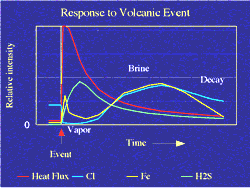| |
Temporal Changes in Hydrothermal Fluid Chemistry
The first
high-temperature submarine hydrothermal systems that were studied over
time maintained very stable fluid composition. This was interpreted as
evidence for equilibrium control of vent fluid composition.
 Large
changes over time in chemical composition of vent fluids were not seen
until 1990, when hydrothermal systems affected by volcanic activity were
first sampled and it became apparent that rapid and significant changes
in the style of venting and fluid compositions occur immediately following
an eruption (Haymon et al. 1993; Butterfield & Massoth 1994; Von Damm
et al. 1995). Seafloor volcanic eruptions clearly have dramatic and interconnected
consequences including formation of megaplumes (event plumes), microbiological
blooms, and rapid evolution of the temperature and composition of vent
fluids (Haymon et al. 1993; Embley & Chadwick 1994; Baker 1995; Baker
et al. 1995; Embley et al. 1995; Lupton et al. 1995; Von Damm et al. 1995;
Holden 1996). With the evidence accumulating from seafloor eruption events
at North Cleft, the East Pacific Rise at 9 50 N, segment, and
the EPR near 17 30 S (Auzende et al. 1994), it is possible to describe
how hydrothermal systems change immediately following a volcanic event
and to estimate how hydrothermal fluxes are affected. Data and observations
from the Juan de Fuca sites have been used to construct a general model
of hydrothermal response and chemical evolution of fluids following a
volcanic event. Large
changes over time in chemical composition of vent fluids were not seen
until 1990, when hydrothermal systems affected by volcanic activity were
first sampled and it became apparent that rapid and significant changes
in the style of venting and fluid compositions occur immediately following
an eruption (Haymon et al. 1993; Butterfield & Massoth 1994; Von Damm
et al. 1995). Seafloor volcanic eruptions clearly have dramatic and interconnected
consequences including formation of megaplumes (event plumes), microbiological
blooms, and rapid evolution of the temperature and composition of vent
fluids (Haymon et al. 1993; Embley & Chadwick 1994; Baker 1995; Baker
et al. 1995; Embley et al. 1995; Lupton et al. 1995; Von Damm et al. 1995;
Holden 1996). With the evidence accumulating from seafloor eruption events
at North Cleft, the East Pacific Rise at 9 50 N, segment, and
the EPR near 17 30 S (Auzende et al. 1994), it is possible to describe
how hydrothermal systems change immediately following a volcanic event
and to estimate how hydrothermal fluxes are affected. Data and observations
from the Juan de Fuca sites have been used to construct a general model
of hydrothermal response and chemical evolution of fluids following a
volcanic event.
(Modified
from Butterfield et al. 1997 Philosophical Transaction of the Royal Society,
volume 355.) Response of hydrothermal systems to a volcanic event. Relative
intensity of heat flux ( red line) and vent fluid concentrations of chloride
(blue line), iron (dotted line), and hydrogen sulfide (thick line) over
time. Systems evolve from a vapor-dominated, high heat flux stage accompanied
by phase separation, through a transition to brine-dominated discharge,
and eventually decay back toward zero heat flux and seawater composition.
The following papers contributed to the formulation of this model: Butterfield
and Massoth, 1994, Von Damm et al. 1995, Lupton
1995, and Baker
1995.
Vent Fluid Chemistry | Circulation Zones
| Fluid-Rock Reaction | Phase
Separation| Temporal Changes | Microbial
Biosphere |
|

